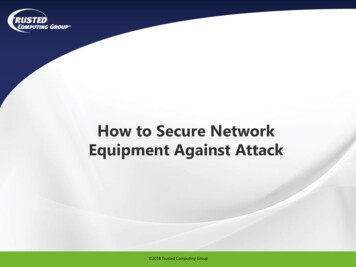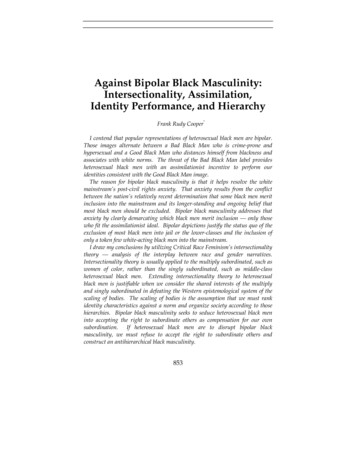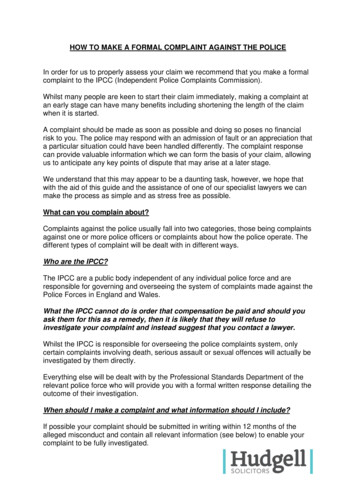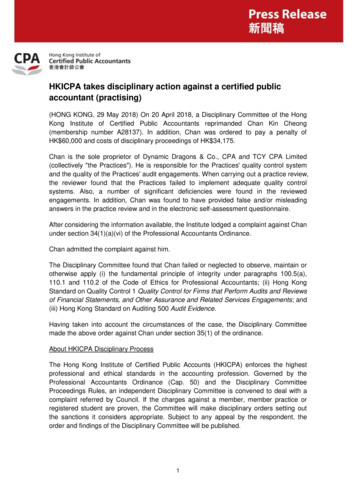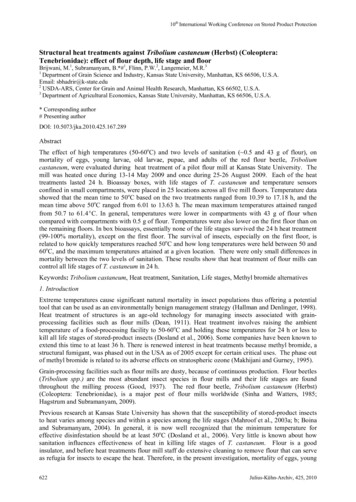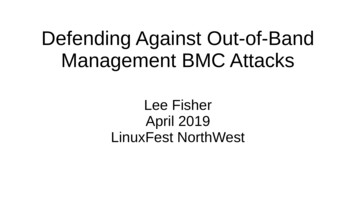
Transcription
Consumer Awareness InstituteTHE CASE (FOR AND) AGAINSTMULTI-LEVEL MARKETING:The Complete Guide to Understandingthe Flaws – and Proving andCountering the Effects – of EndlessChain “Opportunity” Recruitment,or Product-based Pyramid SchemesBy Jon M. Taylor, MBA, Ph.D. 2012, 2011 Jon M. Taylor
TABLE OF CONTENTSNOTE: Because this book is being continually updated, pages are numbered separately withineach chapter.Number of pagesINTRODUCTION – the powerful appeal of MLM, the need for this investigation,10questions to be answered, the book’s title and logical bias, & Summary of FindingsChapter 1: MLM UNDER THE MICROSCOPE – why and how the research uponwhich this book is based was undertaken, and why the author can speakwith authority on the subject (includes 4-page appendix)12Chapter 2: MLM DEFINITIONS AND LEGITIMACY – what MLM is – and is not(includes 17 pages of appendices)48Chapter 3: MARKET SATURATION AND COLLAPSE – MLMs fundamental flaws, andhow established MLMs skirt two major flaws in their systems11Chapter 4: PRODUCTS AND PRICES – questionable MLM product claims – andoverpriced products8Chapter 5: RECRUITING A DOWNLINE – why the emphasis in companycommunications is on selling, while in practice the emphasis is on recruiting –and what it costs to successfully recruit a downline7Chapter 6: ATTRITION RATES OF MLM PARTICIPANTS – why few recruits stay,and why it matters5Chapter 7: MLM'S ABYSMAL NUMBERS – what the data show about MLM as abusiness or income opportunity (includes 13 pages of appendices)49Chapter 8: MLM - A LITANY OF MISREPRESENTATIONS – MLM as a composite lie(includes 33 pages of appendices)40Chapter 9: VILLAINS AND VICTIMS – who are they? (includes 21 pages of appendices) 29Chapter 10: IS MLM LEGAL? Federal and state laws that apply to MLM (includes74 pages of appendicesChapter 11: WHERE IS LAW ENFORCEMENT IN ALL THIS? (includes 13 pages ofappendices)10230Chapter 12: IS MLM A MORAL AND ETHICAL BUSINESS? A surprise answer1Chapter 13: ACTIONS NEEDED – to recover losses and to prevent harm toconsumers (includes conclusions for the book and 7 pages of appendices)14
Intro-2INTRODUCTION: MLM’s appeal – and questions to be answeredPrefaceThis book is intended to meet the needfor a thorough analysis of the businessmodel called multi-level marketing (MLM –a.k.a. “network marketing”) and itsembodiment in the emergence of thousandsof MLM programs (MLMs). Worldwide, tensof thousands of consumers are approacheddaily with promises of income andindependence from joining one of these MLMs.At the outset it should be noted that TheCase (for and) against Multi-level Marketingis not strictly a book of legal arguments forand against MLM, although attorneys andlaw enforcement officials should find itinvaluable in building their cases. I am writingfrom the perspective of a qualified businessanalyst, consumer advocate, instructor inmanagement and ethics, and experiencedentrepreneur and salesman. Since I am notan attorney, when commenting on legalmatters I have been careful to consult withqualified legal counsel and/or experts withextensive law enforcement experience. To allof these I extend my gratitude.ContentsPrefaceMLMs powerful appealThe Amway precedentA much needed investigationThe many questions to be answeredIs MLM an unfair and deceptive practice?The book’s title and logical biasSource material for the bookRecommended reading & web sitesSummary of Findings about MLMI-2I-2I-3I-3I-3I-4I-5I-5I-6I-7MLM’s powerful appealPeople join an MLM program for a varietyof reasons. Most are recruited by someone,often a family member or friend. Some learnabout a program over the Internet or learnabout it from contacts at work.The products are often attractive,seeming to answer some need, such asprotection from illness or aging. They maybe very unique and offer benefits thatpromoters claim are not available elsewhere.The opportunity to be self-employed fromhome appeals to many who are tired ofdepending on fickle employers who can laythem off at any time. They see their work asdead-end jobs with no real long termpotential. Others are unemployed and find inMLM the chance for at least some income.Even some professionals tire of trading timefor money and like the option of owning abusiness that provides passive income.MLM offers an inexpensive alternative tomore expensive options for owning abusiness. It can cost a small fortune to buy afranchise or an established business fromsomeone else, and starting a business fromscratch may take years to get off the ground.MLM is easy to get into and appears to be agood way to be your own boss.Some get into MLM because of apromoter’s promise of virtually unlimitedincome, or at least income proportional tothe time and effort put forth. But some getinto MLM in hopes of supplementing theirincome, paying off debts, or financing collegefor their children. Others are led to believe theycan earn a little extra cash for Christmas or forfamily vacations by working seasonally.And of course you can’t beat the feelingof camaraderie that MLM offers. You aretold that you can be in business for yourself,but not be by yourself. And you are told thatin helping yourself, you will be helping others– often hundreds in the organization yourecruit and build – who look to you forguidance and encouragement, as they eachbuild their own business under you.As Robert Kiyosaki, author of Rich Dad,Poor Dad stated: MLM levels the playingfield and allows the average person tobecome financially free. This means nothaving to punch a time clock, the timefreedom to pursue other interests withouthaving to worry about money, and themeans to be in control of your future. Whowould not want all that?
Intro-3The Amway precedent.In 1979, RobertPitofsky, acting as anadministrative law judgefor the FTC (FederalTradeCommission),ruled that Amway was“notapyramid1scheme.” This rulingassumed Amway’s compliance with certain“retail rules” to assure that products weresold to the public and not just stockpiled.These rules were never edent as justification for their programs,in spite of mountingevidence of misrepresentations in MLM recruitment campaignsand high loss rates among participants.Thousands of MLMs have come and gonesince 1979, and hundreds remain – spreadingvirally from state to state and to vulnerablemarkets overseas.Anyone reading the evidence with anopen mind will understand why I and otherconsumer advocates lament the Amway ruling– and failure to take remedial action since – asrepudiation by FTC officials of the agency’smission to protect consumers from “unfair anddeceptive trade practices.”This is an important topic becausesince 1979, hundreds of millions of MLMparticipants have in the aggregate beenaffected to the tune of hundreds of billionsof dollars worldwide. And whether thesepartici-pants were benefitted or victimized isa topic of hot debate between those whosee MLM as a legitimate type of directselling or home business opportunity – andthose who see it as an inherently flawedand fraudulent business model, causingnearly all participants to suffer losses, onlyto enrich founders and those at or near thetop of their respective pyramids ofparticipants – who are generally the firstones to join the endless chains ofrecruitment.193 F.T.C. 618, 716-17 (1979).MLM is said to level theplaying field and allow theaverage person to becomefinancially free. This meansnot having to punch a timeclock, the time freedom topursue other interests withouthaving to worry about money,and the means to be incontrol of your future. Whowould not want all that?A much needed investigationThis investigation is long overdue. Asurvey of legal and business journals,Internet web sites, and a library of MLMpromotional and training materials yields amountain of opinions on both sides of a verycontentious and ongoing debate about thelegitimacy of MLM. But nothing approachingthis level of research and analysis on theunderlying business model has ever beenundertaken by a qualified independentresearch entity not underwritten by the MLMindustry. I have brought together not only abrief sampling of opinions on both sides, butan assimilation of analytical thinking andindependent research that effectivelyanswers a host of questions.To illustrate the many facets of thistopic, the list below is just a sample of themany questions that have arisen in my 15years of research on this topic – and that willbe addressed in this publication.The many questionsanswered in the booktobeIs MLM a viable business model? Or is itseriously and fundamentally flawed?Is MLM a pyramid scheme in disguise?How can MLM be clearly differentiatedfrom other business models?What is the impact of MLM onindividuals, families, and on society at large?How much money is gained or lostindividually and in the aggregate?Are rewards proportional to effort; or dothose who invest the most, lose the most?
Intro-4Should those who fail, blamethemselves for not “working thesystem” – or blame the MLM as ascam?Can MLMs with their endlesschain of recruitment continueindefinitely, or are they destined forsaturation and ultimate collapse?Are MLMs profitable asbusiness opportunities? And is alifetime of “residual income” possiblefor all who work hard at MLM?Do MLM compensation plans rewardpart-time or seasonal participation withenough income to be worth their time andinvestment?Is MLM an honest business, or is it asystem dependent on misrepresentationsand unfair business practices?Are some MLMs legitimate, and othersscams; and if so, how can one tell thedifference?Can everyone profit from MLM? Or is itjust the founders and those at the top levelsthat reap most of the company payout?Do most recruits merely join to get theproducts at a discount – as promoters claim?Are MLM products what promotersclaim they are? Or are they overhyped andmisrepresented?Does MLM cut out the middleman? Orare MLM products overpriced to pay off themany levels of distributors?Are prices of MLM products competitiveenough to be sold at listed retail prices? Or doMLMs depend on purchases by participantsfor most of their sales revenues?Do MLMs foster good relationships? Ordoes a person risk squandering one's socialcapital by participating in MLM?Does MLM invite openness, or does itlead to more closed and cultish behavior?Do endorsements by famous people andsupport of charities make MLM legitimate?Do “success tools” really benefit users,or do they primarily enrich upline sponsors?Does the DSA (Direct SellingAssociation), the MLM lobby, serve only theinterests of its members, or does it also –with its “Code of Ethics” – seek to protectconsumers from harmful programs?Do its chance elements qualify MLM asa form of gambling, or as a lottery?Are MLMs legal everywhere?If technically illegal in some states,why are they still operating?Whereareconsumerprotection officials in all this? Dothey have the skills, the resources,and the will to challenge fraudulentMLMs?Is MLM ethical? Is unethicalbehavior of participants rewardedmore than ethical behavior?What actions are needed toprotect the public from “unfair and deceptivepractices?”What actions can a victim take torecover losses from MLM?While a resolution of these issues mayseem a daunting task, I am confident thatthese questions are answered here as wellas they can be answered from availableresearch, and that all who read with anopen mind will be better able to answerthese questions for themselves. Hopefully,readers will also be willing to share thisinformation with others to protect them fromloss and disappointment.Is MLM an unfair and deceptivepractice?Many look at MLM as a legitimatebusiness model and attempt to single outindividual programs as “bad actors.” However,in chapters 2 through 8, the reader will findcompelling evidence for the extremeunfairness and deceptive nature of MLM aspracticed throughout the industry. Technically,this should make MLMs subject toprosecution under Section 5 of the FTC Act.Loss rates are extraordinary – over 99%for all of the MLMs for which I have been ableto obtain relevant data. This in itself would notbe so bad, except that it is promoted as an“income opportunity” – or even as a “businessopportunity” – a misrepresentation in itself.After reading these chapters, the readermay wonder if it is appropriate to refer toMLM, with its inherent flaws, as a “business”at all. Some who are familiar with MLM’sabysmal statistics feel it is more appropriate torefer to virtually any MLM as a scam.
Intro-5MLM Loss rates are extraordinary –at least 99% for all of the MLMs forwhich I have been able to obtainrelevant data. This in itself would notbe so bad, except that MLM ispromoted as an “income opportunity”– or even as a “business opportunity”– a misrepresentation in itself.The book’s title and logical biasThe reader may wonder why the strangepunctuation of the title of this book: “The Case(for and) against Multi-level Marketing.” Theparenthesessuggeststhatalthougharguments will be presented both for andagainst MLM, it will be clear from the firstchapter that arguments favoring MLM will notbe emphasized, but will be debunked. This isbecause MLM as a business model is basedon unlimited recruitment of endless chains ofparticipants, as are “pay to play” chain lettersand classic no-product pyramid schemes.Every one of the compensation plans ofthe hundreds of MLMs I have analyzedassume an infinite market and a virgin market,neither of which exists in the real world. MLMas a system is therefore fundamentallyflawed, uneconomic, and deceptive. And inaddition, worldwide feedback stronglysuggests that MLM is also extremely viral andpredatory. The evidence from independentresearch and analysis as reported in this bookwill clearly support these conclusions.The FTC considers classic, no-productpyramid schemes unfair and deceptive andtherefore illegal2. Bruce Craig, formerassistant to the Attorney General ofWisconsin wrote: “The premise of ‘multi-level2In
As Robert Kiyosaki, author of Rich Dad, Poor Dad stated: MLM levels the playing field and allows the average person to become financially free. This means not having to punch a time clock, the time freedom to pursue other interests without having to worry



